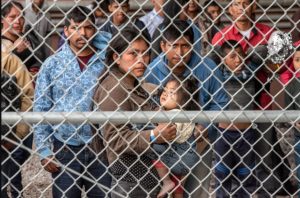Call for tribal language interpreters at southern border
RAPID CITY— Many have questioned the legitimate indigenous status of people struggling to gain access to the United States at our southern border. Regardless of which country or region from which these people are fleeing, from Tierra Del Fuego to the Rio Grande, internet search engines reveal a detailed history of tribal origin and a struggle to maintain that identity.
If restricting population to just those who wholly identify as indigenous, the United Nations (UN) estimated in a 2010 video at “45 million, accounting for 8% of the region’s population.” By region the UN meant any place south of the United States including the Caribbean.
The UN spokesman said “At present, Latin America is home to 826 indigenous peoples, the largest percentage in Bolivia (62.2%), Guatemala (41%), Peru (24%) and Mexico (16%). There is huge diversity among indigenous peoples, with some remaining in voluntary isolation, and some coexisting in big cities.
Indigenous peoples represent one of the most disadvantaged groups in the region and have suffered the systematic loss of their lands, with severe consequences to their well being. Nevertheless, the Economic Commission for Latin America and the Caribbean (ECLAC) has found some progress in recent years related to the recognition of their territorial rights and political participation. There have also been improvements in their living conditions with greater access to health care and education. The UN has championed the promotion of indigenous peoples’ rights and relies on three special resources for this purpose: a permanent forum on indigenous issues; expert mechanism on the rights of indigenous peoples; a special rapporteur (person appointed to report on the proceedings of certain meetings) on the rights of indigenous peoples.”
While many north of the US border, including many tribal members, question whether these people are indeed indigenous, defined as First American in heritage and culture, and not necessarily evolved or created in this hemisphere, the UN established without question that large tribal groups coexist in many countries, speaking their native language and practicing their native traditions.
According to Elizabeth Barrios, Assistant Professor of Spanish & Trans American Latino/a Studies at Albion College, “Many of the people at the border are of Indigenous ancestry, but are now Spanish-speakers, largely (if not always completely) assimilated into the mestizo (racially-mixed) dominant culture from their home country. However, there are also culturally indigenous individuals at the border who only speak Indigenous languages like Triqui, Zapotec or K’iche.”
These are the peoples referred to in the UN video. The video goes on to say: “At a regulatory level indigenous peoples are protected by Convention 169 of the International Labor Organization of 1989 which recognized their rights as peoples for the first time and the UN Declaration on the Rights of Indigenous Peoples of 2007, which considers these peoples’ rights to self determination. In the context of these efforts, ECLAC calls for the regions countries to put policies in practice to end inequality suffered by indigenous peoples. Policies based upon human rights standards and the perspectives and contributions of these indigenous peoples. This is crucial in the construction of a new developmental agenda beyond 2015 with equality at its heart.”
A call went out for interpreters at the US-Mexico border. Not for Spanish, which were in abundance but for tribal languages like Zapotec and Mayan K’iche’, which according to Guatemala’s official government estimate from 2002, was spoken by 1.2 million Guatemalans.
Beyond people with a distinct tribal identity, are many millions more of tribal descent. When these populations are factored in, the numbers nearly double.
Mexico tops the list with nearly 34 million of Native descent. Followed by Bolivia: 10 million; Peru: 6 million; Guatemala: 6 million; Ecuador: 5 million; Chile: 2 million; and six other countries with one million. The Native population of Canada and the United States are only 2 million and 5 million, respectively. Mexico alone has nearly five times that number of people of Native ancestry than the US and Canada combined. The number of indigenous peoples south of the border is not merely enough to beg mention with the numbers north of the border, it exceeds the numbers north of the border by a factor of ten.
Most of these statistics are readily available to any person capable of utilizing an internet search engine but tribes in the US and Canada are loathe to champion the plight of their indigenous cousins to the south. Like prom queens who show up at the prom to find ten other girls who are wearing the exact same dress they are wearing, the tribes north of the border feel their identity and issues are threatened by an overabundance of extra Native peoples they had not previously factored into their collective identity.
In the meantime, the Trump Administration has incarcerated thousands of indigenous peoples, fleeing harsh and deadly conditions in their home countries. The optimistic UN objectives of 2010 have not created the improved living conditions hoped for by 2015. Federally recognized tribes in the US and Canada have said little of their plight, let alone collectively activating on behalf of fellow indigenous.
The question remains, once the indigenous identity of peoples south the border is factually established, will there be a reuniting of Native peoples separated by that border, and the Canadian border? Can they collectively embrace fellow indigenous and vigorously activate on behalf of not only those indigenous incarcerated by border patrol, but for those presently terrorized in their home countries, fleeing north, across border after border of countries which, not only don’t welcome their presence, but countries actively engaged in the very policies that drove the indigenous from their home country.
(James Giago Davies is an enrolled member of the Oglala Lakota tribe. He can be reached at skindiesel@msn.com)

